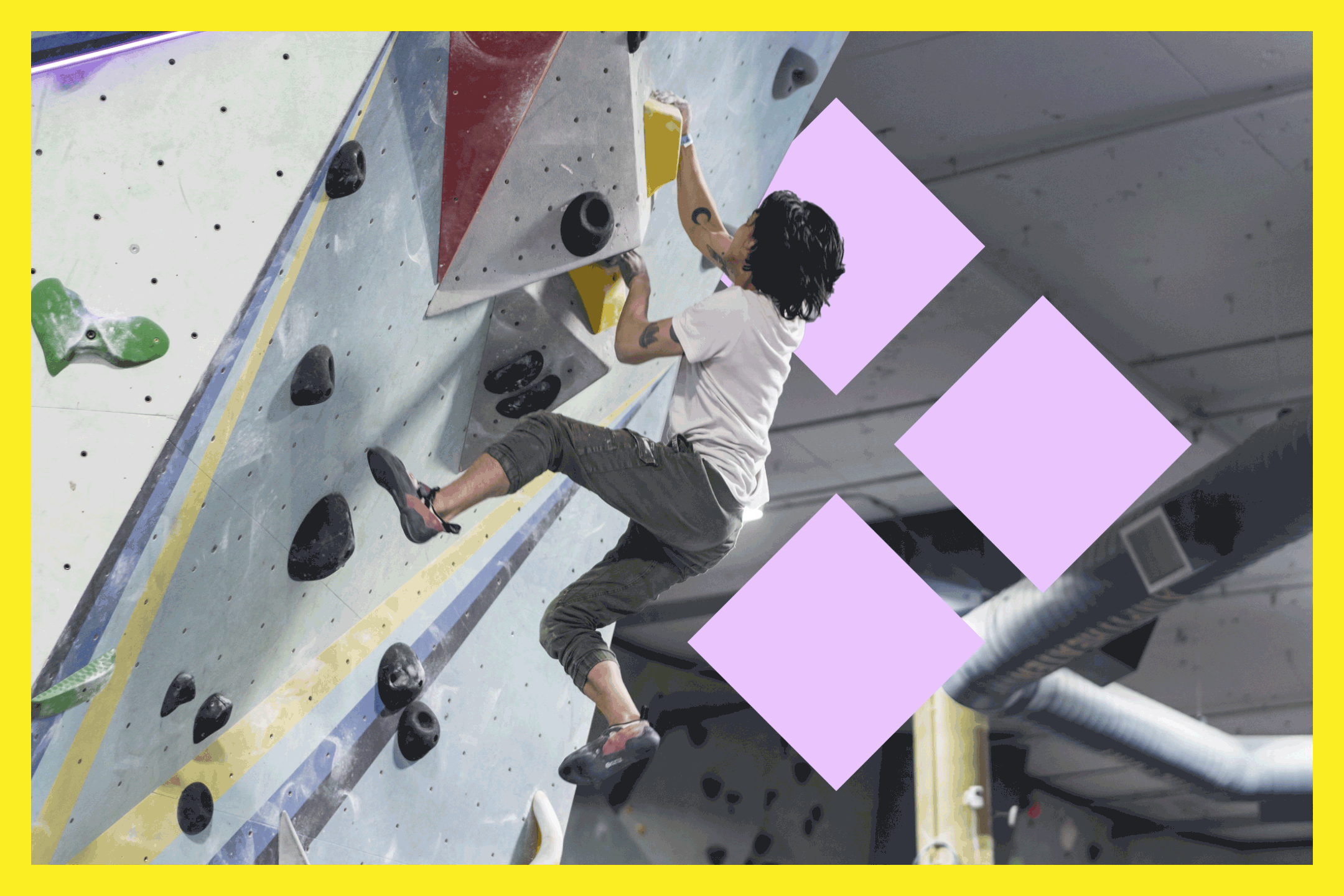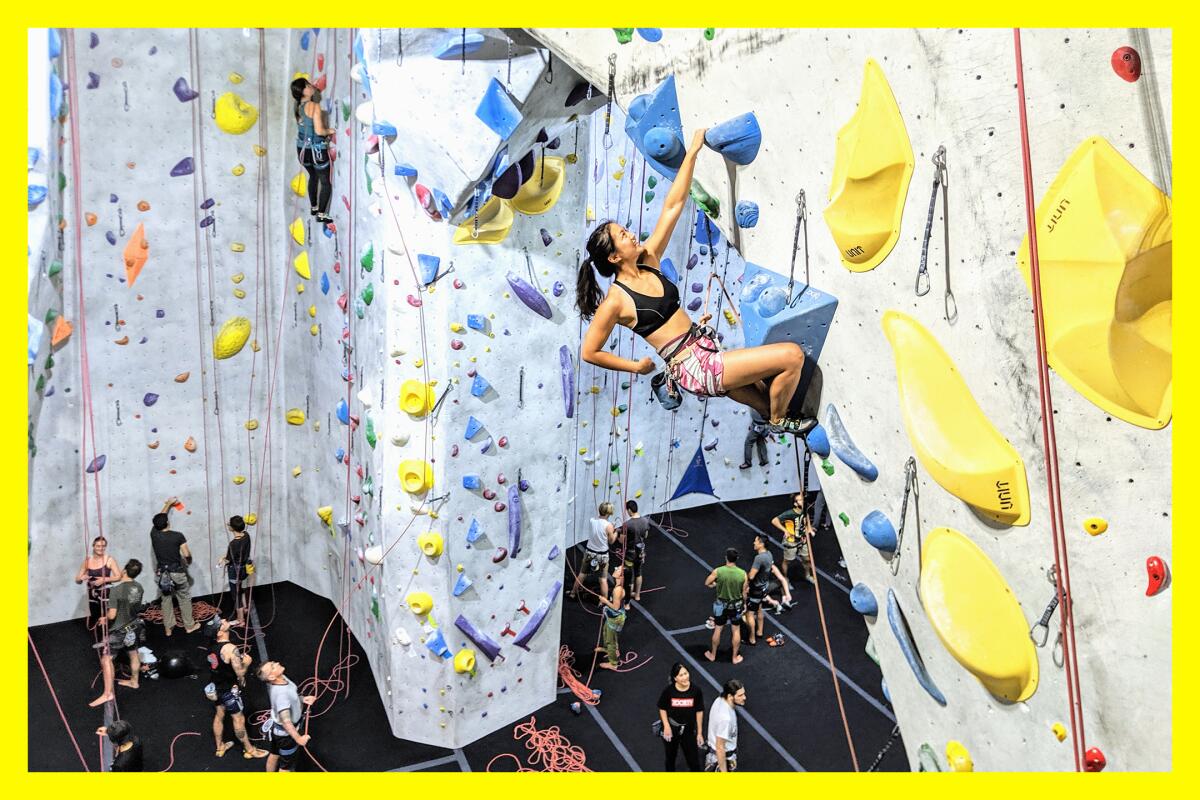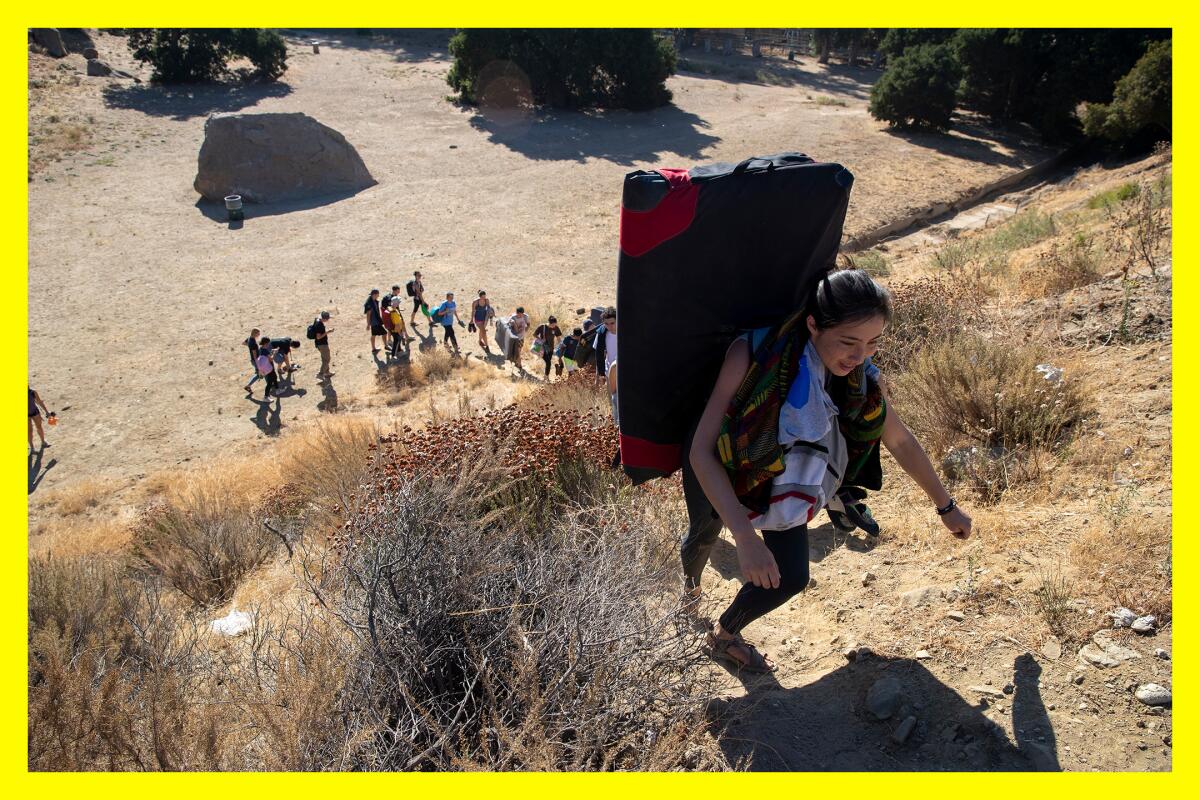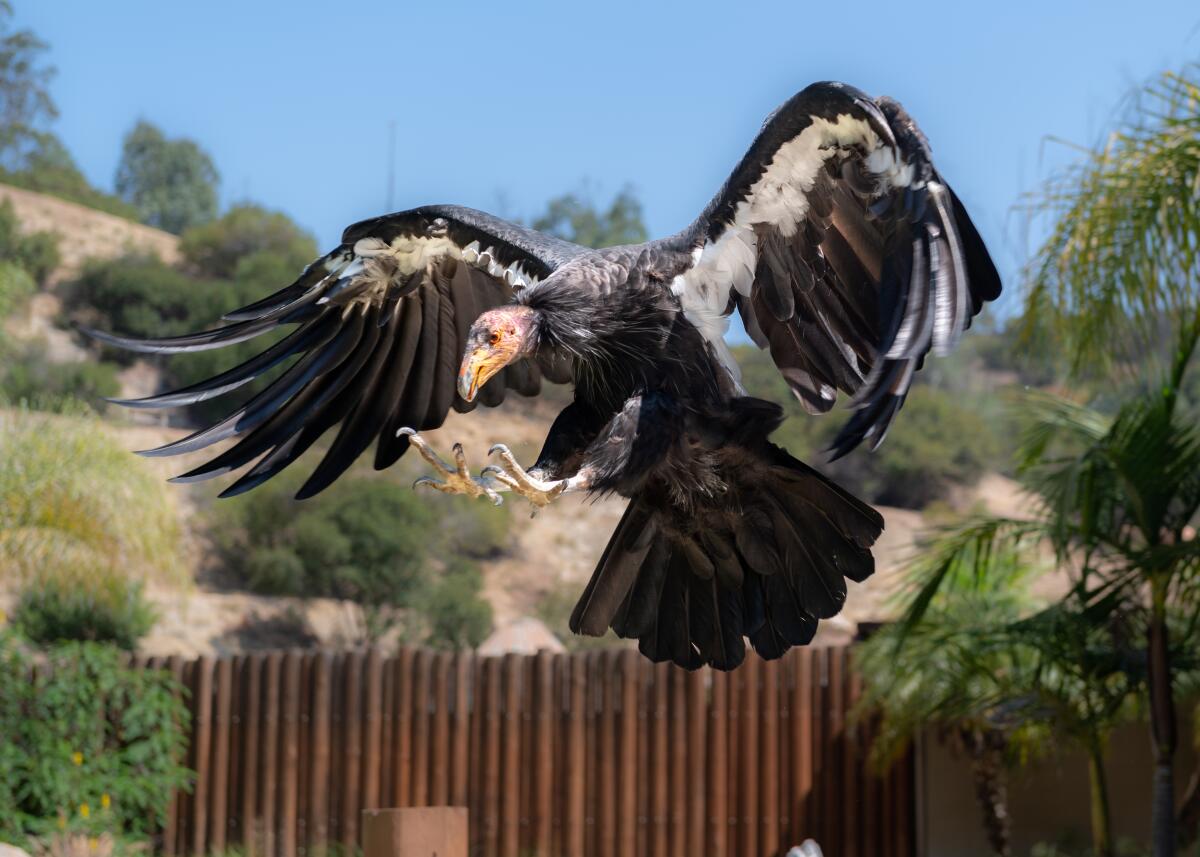4 tips for how to start rock climbing in and around L.A.

- Share via
I’ve never enjoyed walking into a gym.
Growing up as a fat kid, I have enough traumatic memories around exercise to fill several therapy sessions. On top of the shame I had around my body, I also have exercise-induced asthma, which went undiagnosed until I was 25. (My coaches just thought I was out of shape.)
Recently, I decided I wanted to get back to rock climbing. I loved the sport when I lived in Oklahoma City, regularly climbing at grain silos that had been converted into a climbing gym. But returning in L.A. meant walking into a gym.
You are reading The Wild newsletter
Sign up to get expert tips on the best of Southern California's beaches, trails, parks, deserts, forests and mountains in your inbox every Thursday
You may occasionally receive promotional content from the Los Angeles Times.
I signed up for an introductory course on rope climbing to refresh my memory. And then, as a means to ease my anxiety, I decided to write about my experience. I figured that meeting people in the community would help me feel less terrified. Plus, I enjoy sharing my adventures with you.
What I found in the L.A. climbing community was acceptance. The people I interviewed stressed that climbing is for everyone. In L.A., there are several groups that help ensure climbing gyms feel safe, including for queer climbers, BIPOC climbers and climbers with disabilities.
Below are four tips from experienced climbers who hang out at gyms and outdoor climbing spots around L.A. County. I think their advice is encouraging, and I hope you do too.

A glossary of terms
Before diving into the tips, I wanted to briefly define some of the terms you’ll hear in the climbing world.
Top roping: Climbing with a rope attached to your harness that runs up to an anchor system and back down to your belayer, who serves as your brake when you fall.
Belayer: In rope climbing, the person on the wall needs a belayer whose job it is to work the rope, pulling out the slack or giving the climber more rope when requested. Most important, the belayer is there to use the brake in the climbing system when their partner is falling. (As I learned in my climbing class, the belayer should always act as though their partner is about to fall; focus is crucial.)
Bouldering: A form of solo climbing close to the ground where you scramble along a rock wall, aided by climbing shoes and a crash pad on the ground.
Beta: Advice given on how to complete a climb. The most important part of understanding this term is understanding you should not offer unsolicited beta to your fellow climber. You should at least ask, “Can I offer you a tip?” But don’t be surprised if the person declines. Figuring it out yourself is part of the fun!
Climb ratings: When you go to a climbing gym, you’ll see a number on the wall. Generally, it’ll start with a 5. Routes range from 5.1 to, confusingly, 5.10. Although your math teacher taught you that zero is meaningless, in the climbing world if means this is one of the most challenging routes, whether it be in the gym or on a mountain.

1. Start indoors
Obviously, before the advent of indoor rock walls, climbers learned by ambling up cliffs and boulders. And that’s an option still.
Kate Mullen, co-owner of Stronghold Climbing Gym in L.A., told me with a laugh that “it would be crazy as an indoor gym owner” to encourage people to climb outdoors, but Mullen wanted to point out that climbing outside is often free. There’s a long history in L.A., Mullen said, of climbers getting their start at Stoney Point Park in Chatsworth.
It’s tempting to go outside at first. Climbing is not a cheap sport. At minimum, you need a harness and shoes (and probably some chalk). I remember dropping about $200 (and my jaw) when I decided I wanted to climb regularly. Luckily, climbing gyms have rental equipment available, sparing you the initial major investment.
Additionally, by climbing indoors, you can take a short drive to the closest climbing gym and figure out whether you enjoy climbing.
“Some people, even if they’re not ‘good’ at it, they really get that this is a fun game, and they want to play it,” Mullen said. “That kind of joy when they’re doing it is a good sign they should do it.”

Also, climbing indoors offers a controlled environment. In a climbing gym, there aren’t any rocks falling off the wall. The equipment is (or at least, should be) inspected daily. And in some gyms, there are auto-belay devices allowing you to experience the feeling of rope climbing without a partner. Plus, you’ll make friends, which we’ll get to next.
“If you’re going to be climbing outside, you have to take responsibility of the safety factors and deal with the consequences if you make poor judgments,” Mullen said.
If you go to any of L.A.’s popular outdoor climbing spots, Mullen said, you’ll see people climbing without helmets or bouldering without crash pads.
“None of that is ‘wrong.’ You just have to be willing to face the consequences if the worst happens,” Mullen said.
Mullen said she doesn’t want to scare people from climbing outdoors — she hiked and climbed to Lone Pine Peak in the eastern Sierras about five years ago and had a life-changing experience — but you have to be much more prepared than climbing indoors, which still requires astute attention but without rock falls, sun and snakes.

2. Learn the basics through a class and community
Learning to climb also costs money. I paid $40 for my 90-minute introductory course.
The good news is there are climbing groups in L.A. willing to show you the ropes. (I had to!)
Eric Chad Ho, treasurer of Queer Crush, an LGBTQ+ climbing group, told me that their group not only welcomes beginners but also teaches them proper technique.
“We do want to create a safe space for all body types, all gender diversities as well as BIPOC, POC, queer, trans — just everybody’s welcome because we understand being marginalized and how that feels,” Ho said.

Queer Crush captains are experienced climbers with a passion for including everyone, Ho said. At events, captains will ask who is new and then pair people based on their experience and comfort levels.
L.A. climber Shalaka Gole told me about the joy she’s found climbing as a local leader for the L.A. chapter of Brown Girls Climb and with Lagartijas Climbing Crú, a group organized by “people of the majority,” a term that underscores that non-white people make up most of the globe’s population, for climbers of color.
Gole said both groups welcome beginners, and as a bonus, Lagartijas Climbing Crú has a gear library for members to help make the expensive sport more accessible.
“If you’re trying to find your own individual way into this world ... there are so many affinity meet-up groups. Those can be really lovely,” Gole said. “Find your people, and people willing to teach and share.”

3. Develop a ‘belaytionship’
Although you can boulder alone, rock climbing — at least for us beginners — isn’t a solo sport.
For top-rope climbing, you’ll need to develop a “belaytionship,” a partner you not only trust but also know has the skills to keep you safe.
My climbing partner in Oklahoma City was a veteran who had led soldiers in war zones. Needless to say, I knew I could genuinely trust him with my life. He was so good that it has been hard to accept I have to find a new climbing partner here in L.A.
You can sometimes find a belay partner at a gym. Some gyms have a board where you add your name and skill set and that you’re looking for a belay partner. Or if you feel comfortable, you can talk to your fellow climbers in the gym or rock and ask if there’s anyone who can belay you. You can also find a belay partner in the friendships you make at local climbing groups.
But how do you know you have a good belay partner?
Jenna Josif, manager at Verdigo Boulders in Burbank, told me she looks for a few key things in a climbing partner: proper technique and attention to the task at hand and easy clear communication.
“I look at where their hand rests. Do they just act all nonchalant? Or are they on proper movement? I need to know they can technically do what they’re doing and respect it,” Josif said. “I want to be comfortable enough with the person to give me slack or take, loosening the rope or making it tighter. I want to make sure they’re paying attention and can [belay] comfortably with me.”
4. Have fun
As much fun as it is to push yourself, it’s also important to remember: We do this for fun.
Zoey Grinstead, president of Queer Crush, said she stays excited for a sport she’s done for almost 20 years by remembering the joy of it all — the community, the friendships, and yes, the climbing.
“This is your recreational time. This is your free time. Do whatever you want that’s fun,” Grinstead told me. “This sport is not worth it if you’re not having fun. Yeah, there’s colors and different difficulties, but just do whatever you want. It’s your space. You’re going to have a blast no matter what you do. Just have at it.”

I remember when I took out my harness and read over the instructions. It included a tag that read: “Climbing and mountaineering are dangerous. Understand and accept the risks involved before participating. You are responsible for your own actions and decisions.” Not exactly what you find when you open a new pair of hiking boots.
This is the part that often stops people from starting. But I place climbing — as long as it is done responsibly and with proper equipment — in the “safe danger” category.
Yes, there are inherit risks you must accept with the sport. But, as emphasized in the climbing course I took, there are fail-safes, whether that be in the number of ways you’re connected to the rope, or the safety check-ins that you and your belay partner always do before starting a climb. Climbing well is climbing with intention.
And as I learned through talking to those in the L.A. climbing community, climbing well is climbing with a community that accepts you for exactly who you are.

3 things to do

1. Celebrate vultures at the L.A. Zoo
There are a lot of cute birds out there, including hummingbirds, puffins and chickadees. A vulture, including the California condor, probably wouldn’t ever make the list. But these misunderstood roadkill-loving creatures deserve our appreciation. The L.A. Zoo will celebrate International Vulture Awareness Day with a slate of activities from 10 a.m. to 4 p.m. Saturday. There will be zookeeper talks at 11 a.m., 1 p.m. and 3 p.m., and a World of Birds show featuring Cape vultures at noon. You can also enjoy vulture visits with a keeper Q&A at 2:30 p.m. Also, several local groups will be on hand, including Friends of California Condors Wild and Free, U.S. Fish and Wildlife Service California condor recovery program and the San Fernando Valley Audubon Society. Free with paid zoo admission. Learn more at lazoo.org.
2. Learn about edible California native plants online
Join the California Native Plants Society for a webinar at 5:30 p.m. today on edible California plants. Ann-Marie Benz, the organization’s horticulture program manager, will teach participants how to grow native plants as food. Benz will also discuss the health benefits, sustainable gardening practices and tips for blending native plants into your home’s landscape. Sign up online through this link.
3. Learn about your community on California Biodiversity Day
Starting Saturday, Californians across the state will celebrate California Biodiversity Day with a slate of events, including hikes, data collection and art exhibits. Here in L.A., you can help maintain the trails and restore habitat from 7 to 10 a.m. Saturday at Rubio Canyon with the Arroyos & Foothills Conservancy. On Sunday, you can collect data with the California National Plant Society’s San Gabriel Mountains chapter from 9 a.m. to noon at Islip Saddle. Participants will use the iNaturalist app on their phones to collect data on plants and animals in the area. Depending on time, the group will hike up to three miles with about 630 feet elevation gained. For a listing of other California Biodiversity Day events near you, visit calacademy.org.

The must-read

One of the worst sounds you can hear while out hiking is that of a helicopter — a signal that someone nearby has suffered an emergency on the trail. What would it take to prevent accidents like these from the start? A team at Joshua Tree National Park is finding out. Launched in 2021, the Preventative Search and Rescue Program team members station themselves at high-risk areas of the park where they anticipate visitors might get into trouble. The team logged a whopping 13,200 “preventive actions” in the last fiscal year. As Times environment reporter Alex Wigglesworth reported, 15 parks have launched these preventive programs and at least 30 more are considering or starting one. The idea of a team to prevent emergencies started at the Grand Canyon. “Grand Canyon was doing a great job of that, knowing that about 3, 4 o’clock in the afternoon, three miles down on the Bright Angel trail, everybody’s throwing up,” said ranger Anna Marini, who coordinates the team at Joshua Tree. “It’s the worst time. They’ve been hiking too long. So they send somebody out there at that time.”
Let’s all take a moment to appreciate this team of mostly volunteers helping better ensure that families and friends make good memories at the park.
Happy adventuring,

P.S.
I am not sure whether y’all noticed, but it’s hot outside. It feels as if September saw that July was California’s hottest month on record and said, “Hold my beer.” This is a challenging time of year for outdoorsy folks, as we’re always dreaming up our next hike. If you’re considering a trip to Joshua Tree, please take a moment to read this guide about how to keep yourself out of trouble as you venture through the desert. The guide includes great tips regardless of where you’re hiking. Stay safe out there!
For more insider tips on Southern California’s beaches, trails and parks, check out past editions of The Wild. And to view this newsletter in your browser, click here.
Sign up for The Wild
We’ll help you find the best places to hike, bike and run, as well as the perfect silent spots for meditation and yoga.
You may occasionally receive promotional content from the Los Angeles Times.




